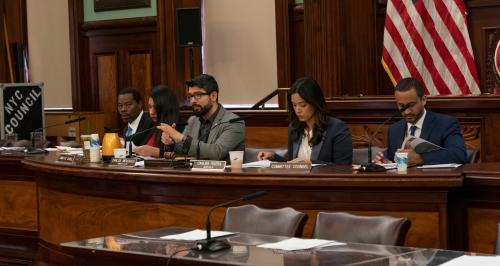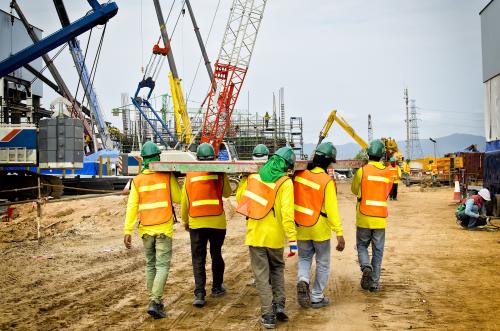When President Joe Biden signed the American Rescue Plan Act (ARP) into law last March, it was a momentous occasion for local governments around the country. In contrast to past federal fiscal relief efforts—including the CARES Act of 2020—ARP provided a large number of cities and counties with direct, flexible support from the federal government. And the sums on offer were substantial: $130 billion in Fiscal Recovery Funds (FRF) for cities, counties, and tribes, often amounting to significant shares of local governments’ annual budgets.
The Treasury Department began disbursing these dollars in May, requiring larger recipients to submit initial reports by this week on how they are allocating the dollars to address the impacts of the COVID-19 pandemic, and to “build back better” for the future.
In turn, many big cities are telling Treasury: We’ll get back to you on that.
That’s one takeaway from our preliminary examination of plans that 20 large cities around the country have made available. These cities are slated to receive anywhere from $142 million (Charlotte, N.C.) to $827 million (Detroit) in flexible funds from ARP, for a combined total of $7.4 billion—only 18% of which, we’ve found, has been committed so far.
Many cities report not yet spending any FRF dollars
As part of Treasury’s reporting requirements for ARP, cities and counties with populations of at least 250,000 had to declare the FRF amounts they had spent through July 31 across a series of eligible expenditure categories: public health, economic support to households and businesses, services to disproportionately impacted communities, premium pay for essential workers, broadband/water/sewer infrastructure, and revenue replacement.
Among the 20 city plans we examined, eight reported no expenditures at all through July. A couple others reported spending just tiny shares of their allocated funds. In total, the cities reported committing $1.3 billion, or 18% of their combined $7.4 billion allocation.
This is not necessarily surprising nor worrisome. Cities have received only half of their FRF dollars, with the second half scheduled to arrive in May 2022. Moreover, Treasury counseled cities to not commit all of their dollars immediately, so that they could respond to changing health and economic circumstances over the coming months.
The overall signal from many big cities seems to be that they do not feel under immediate pressure to commit and spend the first tranche of flexible federal dollars. In some cities, plans are still working their way through the legislative process. In others, as researchers from the Nowak Metro Finance Lab note, a bottom-up community engagement process to inform allocations is still playing out. And many cities may be awaiting the publication of the final Treasury FRF rule, so they can be sure their spending priorities meet official eligibility requirements.
Among cities with spending plans, some priorities are emerging
Across both cities that have reported early expenditures to Treasury and cities that have announced detailed spending proposals, a couple areas of emphasis (and non-emphasis) are emerging.

Many cities are reserving a sizable portion of their FRF allocation for revenue replacement. The Treasury guidance permits cities to use the funds to make up their estimated revenue shortfall from the prior year attributable to the pandemic economic crisis. From there, cities have broad latitude to use those dollars to support government services. Buffalo, N.Y., Houston, and Kansas City, Mo. report that they are dedicating roughly one-third of their FRF allocation to revenue replacement. Pittsburgh, meanwhile, reports that it will dedicate all of its funds to this purpose—although the city goes on to enumerate a number of specific needs those funds will help it address. Differences in how cities are prioritizing revenue replacement may largely reflect variation in how the pandemic affected their finances, due to different local tax structures. For these cities that reported spending plans, revenue replacement represents 39% of total committed funds.
A number of cities are planning to use—or already have used—significant funds to address challenges facing low-income and other disproportionately impacted communities. The interim Treasury rule provides local governments with fairly wide latitude in this area. St. Louis, for instance, has committed nearly $72 million (about 16% of its total allocation) to helping such communities, including shelter and services for the homeless, funds to prevent eviction, and programs for young people. Boston, Minneapolis, and Seattle also plan to dedicate significant FRF dollars to address affordable housing needs and combat homelessness. In Buffalo, investment in city parks—especially in low-income neighborhoods and for child-related amenities—represents one of the largest planned expenditures. Services to disproportionately impacted communities account for 21% of the $1.3 billion the 20 cities have thus far committed. Some cities that have announced plans not yet reflected in official reports—such as Detroit, Pittsburgh, St. Paul, Minn., and Austin, Texas—are poised to make large commitments in this area too.
Other expenditure areas—including support for small businesses and impacted industries, job training, neighborhood/corridor revitalization, and direct cash/nutrition assistance to households—have received varying levels of attention and investment across published city plans. Some of these represent important priorities in cities that have announced plans but not yet reported expending dollars (e.g., Detroit, Syracuse, N.Y., and Akron, Ohio). Meanwhile, infrastructure (broadband, water, and sewer) has received notably less emphasis in initial plans, probably because cities are anticipating even more significant resources soon on offer from the infrastructure package making its way through Congress.
The bottom line: Lots of room for thoughtfulness and creativity
Perhaps the most important takeaway from this initial scan of city recovery plans is how much room remains for city leaders to adopt thoughtful, evidence-based, equity-oriented approaches to using these substantial one-time funds. Cities that got out of the gate with comprehensive plans bridging high-level goals with project-level details—such as Boston, Buffalo, St. Louis, and Seattle—offer models for how other cities can approach this historic opportunity.
At the end of October, cities are scheduled to submit even more detailed reports to Treasury, listing their FRF expenditures at a project level. As more plans hit the streets, Brookings Metro will highlight both the emerging high-level trends as well as the most innovative ways cities are designing their strategies and deploying their resources to recover from the pandemic and make bold, long-term investments.
The Brookings Institution is committed to quality, independence, and impact.
We are supported by a diverse array of funders. In line with our values and policies, each Brookings publication represents the sole views of its author(s).








Commentary
Cities are taking it slow with American Rescue Plan funds
September 7, 2021